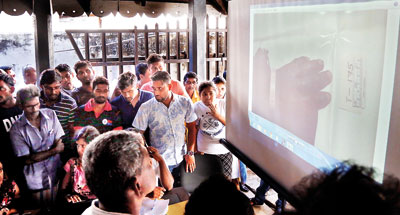Sunday Times 2
Identification of the dead in mass disasters
View(s):A mass disaster is an occurrence of a calamitous event, usually sudden and violent, resulting in a large number of victims, dead or injured, substantial material damage, and a significant disruption of society. The events of April 21 had all these features.

Relatives of victims of the Easter attacks attempt to identify the remains of their loved ones at the Police Mortuary, where photographs of body parts are displayed on a large screen. Pic by M A Pushpa Kumara
Forensic pathologists have a major role to play in mass disasters. The duties and obligations of pathologists investigating a particular disaster are many.
They have to assist the police in establishing the identity of each victim. They have to establish the nature of the injuries, and the cause of death. During autopsies, they have to collect pathological evidence to identify the cause of the particular disaster, and to assist in determining whether it is of criminal, accidental or natural origin, and whether any act of negligence caused or contributed to it.
Forensic pathologists have to collect pathological and other trace evidence, and produce documentary information, which would be of relevance to an inquest and to criminal and/or civil court proceedings.
They have to complete the pathological investigation with the maximum degree of thoroughness, coupled with minimum delay. This would enable bodies of the victims to be released to the bereaved relatives as soon as possible, but only after all relevant investigations have been satisfactorily completed.
Forensic pathologists should always bear in mind, when deciding the particular investigative procedures which are to be pursued, that the principle objectives are:
n The identification
n The detailed examination, and,
n The disposal of the dead as expeditiously as possible.
When nearly 260 local and foreign individuals died in the April 21 disaster, forensic pathologists in Colombo, Colombo South, Negombo and Batticoloa did their duty with dedication.
Personal identification is defined as establishing the identity of an individual. The need for personal identification arises in natural mass disasters like earthquakes, tsunamis, landslides, floods etc, and in man-made disasters such as bomb blasts and mass murders.
In cases when the body is decomposed or dismembered to deliberately conceal the identity of the individual, the need to identify the dead is obvious for social and medico-legal purposes. Various techniques of biological anthropology are employed in the process of identifying the individuals from the bones or the body parts. The identification of the dead from the bones/body parts in a legal setting forms an essential component of forensic anthropology.
In a mass disaster, many bodies can be identified by facial features. Sometimes relatives, who are under severe stress, can make errors in identification.
When facial identification is not possible, the personal identification consists of determination of age, sex, stature and ethnicity. The identification process involves comparing two sets of information – data collected about a person, compared with information from the dead body. Forensic pathologists look for features that match.
In many cases, there is a coordinated effort by different agencies – coroner, law enforcement agencies and the forensic pathologist. If a possible match is found, all the relevant information must be checked for accuracy and consistency. However, not all evidence has the same value for identification. For example, if the clothing found with the body appears to match the description given in the ante-mortem record, this provides only a presumptive identification, not a positive identification.
On the other hand, if the fingerprints taken on the body match the fingerprints taken when the person was alive, this is considered a positive identification, because the probability of two individuals having the same print is very low. Positive identification may also be made through ante-mortem and post-mortem comparisons of dental or medical X-rays, distinct fractures, tattoos or particular diseases.
The final confirmatory identification today is by DNA analysis. It was Sir Alec Jeffreys, a British geneticist, who developed techniques for genetic fingerprinting and DNA profiling, which are now used worldwide in forensic science to assist police detectives in their work, and to resolve paternity and immigration disputes.
Sir Jeffreys worked on mammalian genes as a research fellow. He came to the University of Leicester in 1977, where in 1984, he discovered a method of showing variations between individuals’ DNA, inventing and developing genetic fingerprinting.
In the April 21 disaster, it is extremely important to correctly identify the perpetrators, or the suicide bombers.
The Government Analyst’s Department (GAD) said last month that DNA tests had matched, and confirmed the identity of the suicide bombers. The tests were performed by GAD using blood samples collected from their close relatives.
One of the Shangri-La bombers was Zahran Hashim, the leader of the local jihadist group responsible for the attacks. Hashim headed the National Thowheed Jamath (NTJ). He attacked the Shangri-La with Ilham Ahmed Mohamed Ibrahim. Ilham’s elder brother Inshaf Ahmed was the man who bombed the Cinnamon Grand hotel. The Kingsbury, was bombed by Mohamed Azzam Mubarak Mohamed.
St Anthony’s Church was targeted by local resident Ahmed Muaz. The St Sebastian bomber was Mohamed Hasthun, a resident from the island’s east. The Christian Zion church in Batticaloa was hit by local resident, Mohamed Nasser Mohamed Asad.
The man who failed to set a bomb off at a luxury hotel, but detonated his explosives at a guest house in Dehiwela was identified as Abdul Latheef.
Shortly after the hotel bomb attacks, Fathima Ilham, the wife of the younger of the two brothers, blasted explosives strapped to herself, killing her two children and three police officers who rushed to the family home in Colombo.
Professor Ravindra Fernando
(Emeritus Professor of Forensic Medicine and Toxicology, University of Colombo, Senior Professor of Forensic Medicine, Sir John Kotelawala Defence University. He can be contacted via ravindrafernando@hotmail.co.uk)

